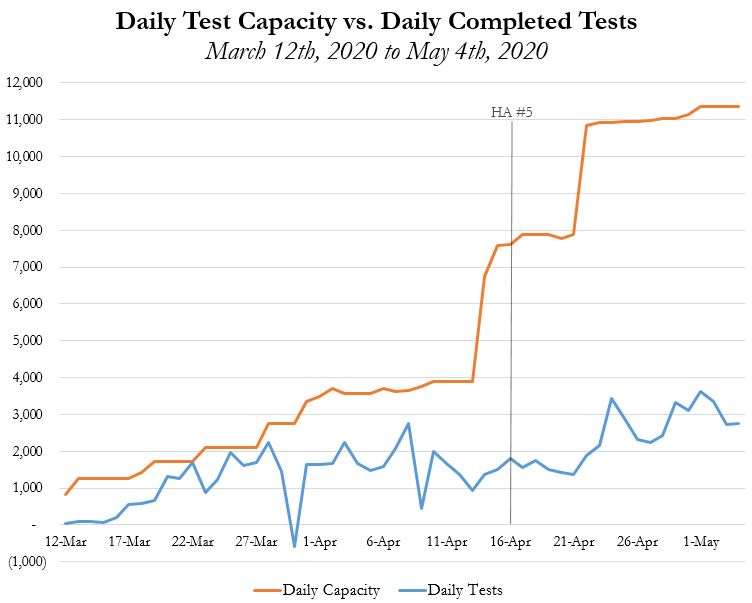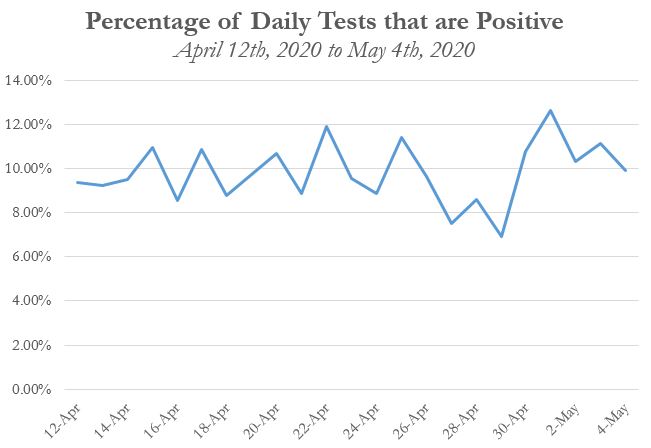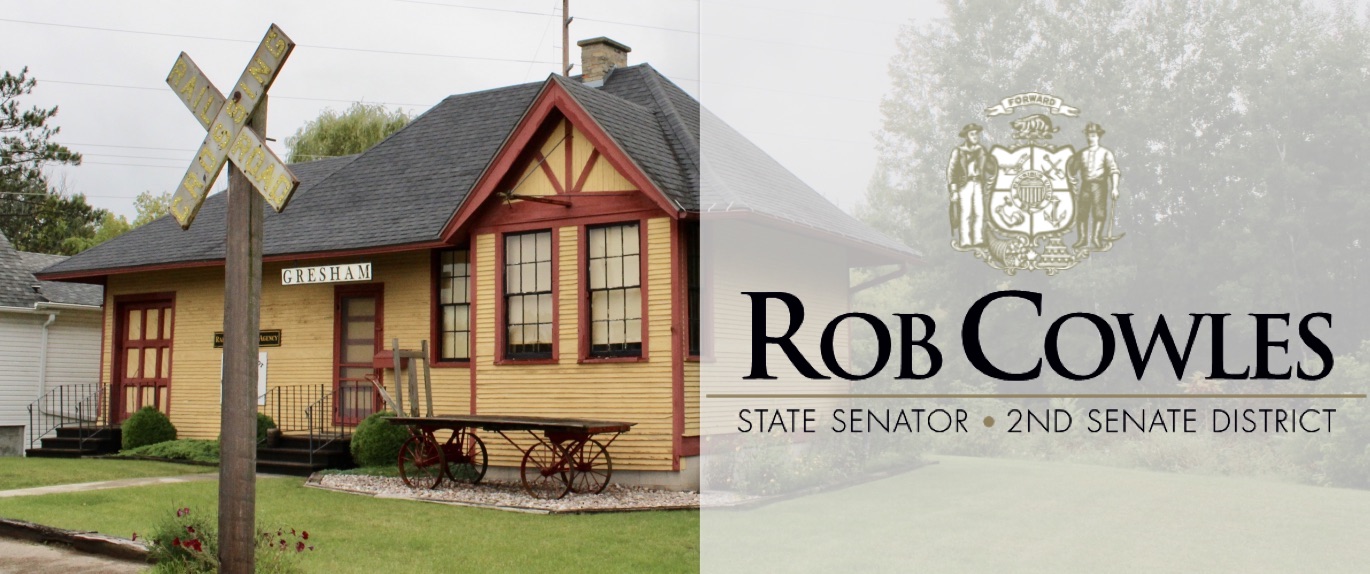|
Dear Friends and Neighbors,
As the situation around COVID-19 in Wisconsin continues
to develop, I’m writing today with an overview of
COVID-19 testing in Wisconsin plus some additional
updates and a few reminders that you may find useful. As
always, I hope this email finds you well, and I hope you
find this information to be helpful as we all navigate
these trying times.
Changes Made to ‘Safer at Home’ Order
Recently, new changes to Governor Evers and Department
of Health Services Secretary-designee Andrea Palm’s
‘Safer at Home’ order went into effect that will provide
more flexibility for some businesses. An update made
last week to the ‘Safer at Home’ order also clarifies
some other business operations, and I’ll briefly go over
these changes here.
Retail and Service Business Operations
The most important change allows so-called
‘non-essential businesses’ in the retail sector to
expand their actions from ‘minimal basic operations’ to
now include deliveries, mailings, and curbside pick-ups.
This includes arts and crafts stores, which may now
expand operations for materials necessary to make face
masks and other personal protective equipment and pet
grooming businesses that may now reopen with curbside
animal drop-off and certain other limitations.
Additionally, lawn care and landscaping businesses may
now perform aesthetic or optional outdoor work including
with one person per site.
For parents looking for ways to occupy their children’s
time and for all residents looking to get through this
outbreak and spring showers, public libraries may now
provide curb-side pick-up. Golf courses, which were
previously closed, may now open, but tee times and
scheduling must be done online or over the phone and
clubhouses and pro shops may not open except for golfers
to use the restrooms. Residents looking to get outside
and stay active in other ways now have more options too,
with kayak and boat rental businesses among others that
may resume operations with some limitations.
I support relaxing these restrictions, and it’s my hope
that we continue to see further steps to safely loosen
restrictions soon.
Manufacturing and Retail Business Processes
For businesses that are open, particularly in
manufacturing, the order also requires that they must
increase cleaning and adopt practices that prevent
workers that may have COVID-19 from showing up to work.
In retail establishments, the order dictates that stores
must limit the number of people inside, and large stores
must offer at least two hours per week dedicated to
shopping for vulnerable populations; something that many
stores throughout the state have already done.
You can read
Emergency Order #28, the extension of the ‘Safer at
Home’ order, along with a
frequently asked questions document about the order
on Governor Evers’ website. Emergency Order #28 was also
expanded on by Emergency Order #34, which you can read
here.
State Parks
Another recent action by the Governor’s Administration
will reopen 34 of the 40 State Parks and Forests last
Friday, May 1st. This includes High Cliff State Park
just outside the 2nd Senate District in the Fox Valley
which was one of the properties impacted by a closure
announced in April.
As the days get longer and temperatures get warmer, and
with the general inland fishing season underway, there’s
no question that Wisconsinites want to get out of their
house and safely enjoy some time outdoors. I am pleased
to see that comments I made to the Department of Natural
Resources (DNR) Secretary after the closures were
announced were accepted. I requested a phone meeting
with the Secretary as I heard input from many
Wisconsinites regarding the state parks closure. I was
very happy to see the advocacy pay off as the
announcement came to reopen these properties.
Residents looking to enjoy time in the State Park System
will notice some changes to park operations, including
the reinstatement of admission fees. In addition, some
parks have restricted hours, predetermined capacity
limits at some properties including High Cliff, and
other restrictions to limit the potential for the virus
to spread in State Parks.
Sunshine and fresh air aren’t only important for our
physical health, but also our mental wellbeing. This
decision isn’t only in the best interest of Wisconsin
residents, but it is also the latest sign that Wisconsin
is beginning to move towards a reasonable, yet timely
loosening of restrictions. Learn more about the
reopening of these State Parks and the restrictions
being kept in place on the
DNR’s website. Also keep in mind, local governments
may close public parks and open spaces under their
operation at their own discretion if areas become
overcrowded.
Brown County Now Offering Community Testing
The Brown County Health Department has expanded their
COVID-19 testing site at the Resch Center to serve
ALL
community members starting today. If you live or work in
Brown County and have symptoms of COVID-19, you can
visit
their website to register for an appointment to
receive a free test and get your results in a matter of
days. Thank you to Brown County, the Wisconsin National
Guard, and local healthcare providers for your combined
efforts to make this crucial service available!
Overview of COVID-19 Testing in Wisconsin
Along with the extension of the ‘Safer at Home’ order
outlined above, the Governor announced his ‘Badger
Bounce Back’ plan to safely ‘reopen’ the State. While I
support the idea of safely reopen our economy, I also
have concerns that the ‘Badger Bounce Back’ plan has too
much ambiguity to be adequately followed and
implemented.
I believe that a plan to reopen Wisconsin needs to weigh
the health and economic status in the state, and further
that a plan must be specific, measurable, achievable,
and timely. Today, I want to give an overview of the
status of COVID-19 testing in Wisconsin and how testing
must play a key role in getting Wisconsin on a track
back to normal.
As you’ve likely heard news stories about antibody, or
serology testing, done with a blood sample, please note
that all of this information here only relates to acute
diagnosis testing, done with a nasal swab. Acute testing
is the only diagnostic test that actually tells patients
whether they currently have COVID-19. Antibody tests
only provide information on whether you’ve had, but
recovered from COVID-19.
Status of Diagnostic Testing in Wisconsin
As of May 4th, 88,703 tests for COVID-19 have been
completed in Wisconsin. If you presume only one tests
was administered per person, the number of tests would
represent 1.52% of our state’s population. Of those
tests, 8,236 have been positive for COVID-19, or 9.28%
of total tests completed. Thanks to the expansion of
public-private partnerships, Wisconsin’s lab testing
capacity has continued to grow, now exceeding the
capability to process over 11,000 tests per day by 51
different labs. The increased capacity has also meant
that many tests can be processed in just a few hours,
instead of the days that patients had to wait to receive
results just a few weeks ago.
However, this creates the first distinction that I’d
like to note:
capacity is not testing. While Wisconsin
has taken and important first step to help us safely
reopen by growing the state’s ability to ‘process’
tests, Wisconsin has not dramatically increased actual
testing on a daily basis. The chart below shows
Wisconsin’s capacity for
testing versus the number of tests that have been
completed daily since the Public Health Emergency
began.

Indicated on the chart above is Health Alert (HA) #5,
which is meant to be a turning point in the state’s
approach to testing. Released by the state Department of
Health Services (DHS), Health Alerts are communications
released to medical providers throughout the state that
provide guidance on responding to different health
ailments. In an earlier HA, #3, the Department
recommended only testing hospitalized patients with
symptoms of COVID-19, health care workers who are
symptomatic, and nursing home residents in facilities
with outbreaks.
HA #5 represents a dramatic expansion of testing
guidance, DHS is now recommending and asking providers
to test everyone who is symptomatic for
COVID-19, not just hospitalized patients. While this
guidance should have resulted in a substantial increase
in testing, as you can see on the chart, we’ve fallen
woefully short and aren’t testing many more people on a
daily basis than Wisconsin was testing before the
expanded guidance. Additionally, we’re falling well
short of our capacity or the ability to ‘process’ tests.
Problems Preventing the Expansion of Testing
There are a number of impediments that have caused
issues with the expansion of testing in Wisconsin, many
of which are unfortunately out of the control of the
state government. The biggest roadblock continues to be
supplies. Testing supplies, primarily nasal swabs and
reagents (the chemical used to run the tests), are in
short supply nation and world-wide. As distribution
chains for these supplies are often international, not
domestic, it’s difficult to easily obtain more
individual components necessary to test or completed
test kits.
Once complete test kits are available, there can often
be distribution issues. Some providers report no
shortages in kits, and UW Health even chooses to test
everyone receiving an essential procedure. But in more
rural areas, providers note that lower prioritization
and less purchasing power leads to an inability to get
kits or all the testing supplies contained in a kit. The
State Emergency Operations Center (SEOC), a cooperative
effort between state agencies to respond to emergencies
and housed at the Department of Military Affairs (DMA),
has established a distribution system to help alleviate
concerns, and DHS through another health alert, HA #6,
has created a site for provider requests.
Overall, these issues and others preventing the state
from dramatically increasing testing in Wisconsin has
begun to be alleviated, but there’s still work to be
done.
Cost of Testing
The cost of a COVID-19 test should be free to a patient
due to federal and state law changes that ensures
government plans, including Medicare and Medicaid, and
private plans that otherwise cover infectious disease
testing offer COVID-19 testing coverage with no copays,
no deductibles, and no other insurance charges. Federal
changes have also provided funding for hospitals to
perform COVID-19 testing to uninsured patients at no
cost.
While tests should be provided for free to patients that
have had a test requested by a provider, testing costs
may otherwise range from about $70 to about $150, with
only a portion of the cost being covered by the patient
if they’re insured. This leaves a portion of the costs
that have to be covered by the health care system.
Role of Testing for ‘Reopening’ Wisconsin
Over the past two weeks, Wisconsin has tested an average
of 2,686 people per day. This is important because,
under Governor Evers ‘Badger Bounce Back’ plan mentioned
above, he’s looking to ramp up testing to 85,000 per
week, average about 12,000 tests per day. That’s more
than a four-fold increase from our current testing
rates!
Increased testing is only part of the plan, as the plan
also sets four benchmarks to enter the three different
phases of the reopening plan. One of those benchmarks
requires a 14-day decline in the total number of new
positive cases. While this was left open-ended in the
plan, further elaboration in a press conference from DHS
showed that they’re looking at the total number of new
positive cases as a percentage of total new tests. I’ve
included a second chart below with the
daily number of cases that
are positive as a percentage of total tests.

As you can see by this chart, even as Wisconsin started
to see a downward trend mid-last week in total cases
that are positive as an overall percentage of tests,
there has been a recent spike in cases as a percentage
of total tests over the past few days. This leads to my
overall concern with the ‘Badger Bounce Back’ plan.
While we need to have a safe and reliable reopening of
the remaining businesses that are closed, it also needs
to be specific, measurable, achievable, and timely as I
laid out above. However, I worry that the Governor’s
criteria are not specific, measurable, or achievable
given the issues we’ve had with acquiring tests,
performing actual tests and given the ambiguities in the
plan (for example, if there’s an outlier day or series
of days, can we discount those days and continue our
trend).
My Idea to Expand Community Testing
In closing, I wanted to share an idea I expressed
support for in a letter to the DHS Secretary that would
make COVID-19 testing more readily accessible in
Wisconsin. Iowa, with a smaller population than
Wisconsin, has begun testing more residents per day than
Wisconsin thanks to their TestIowa website.
This new tool allows residents to have questions
answered about their symptoms, express concerns about
potential sources of exposure, and, if a health
professional deems it necessary, the site provides
participants with a unique barcode along with a time and
location for drive-through testing options.
Giving residents easy and safe access to testing should
be one of our top priorities. That’s why I’m hoping to
see Wisconsin take steps like Iowa to offer a new and
easy testing option that can help us to find, isolate,
and track more COVID-19 cases sooner, creating an easier
and safer reopening.
Checking Your Symptoms and Getting a Test
The symptoms of COVID-19 may appear within two days or
even two weeks after exposure to the illness, and range
from a cough and shortness of breath to fever, chills,
muscle pain, headaches, sore throat, and a loss of taste
of smell, according to the
federal Centers for Disease Control and Prevention.
While the symptoms and the severity of the symptoms
varies by individual with COVID-19, new state Department
of Health Services’ (DHS) guidance encourages anyone
that is symptomatic to seek a test.
However, DHS also advises that anyone who’s symptomatic
should not head to their doctor’s office or walk-in
clinic right away, but instead that they should call
their health care provider to ask for the next steps to
avoid unintentionally spreading the illness. If you’re
symptomatic, you can also use DHS’s new
Wisconsin Health
Connect website where you can enter your symptoms
and hear from a RN with advice on your next steps.
Advocating for Brown County
I’ve heard from constituents asking particular questions
with regards to the outbreak in Brown County. While
details and updates are being modified daily, I’ve been
in conversations with local and federal officials and
the Governor’s Office to advocate for as much assistance
as the state can provide in addressing this outbreak.
I fully anticipate having additional details on this
topic in my next e-newsletter.
Virtual Learning Opportunities
Looking to pass some time while at home with your kids?
Try some of these new interactive and educational
websites.
First, the state Department of Children and Families
(DCF) has created an online library with dozens of
resources for engaged learning. The library even
includes some virtual ‘field trips’ where you can visit
farms, museums, and zoos from the comfort of your
kitchen table or living room. Find these different
resources on
DCF's website.
The Wisconsin Maritime Museum is also looking to bring
their exhibits to your home with their new Online
Resource Portal. On their website, you can explore their
virtual ‘field trips’, find downloadable lesson plans,
live-stream programs, and discover more activities that
are bound to keep your kids anchored down and
entertained for quite a while. Check out these
activities on
the Maritime Museum's website.
Finally, PBS Wisconsin is continuing their collaboration
with the state Department of Public Instruction to make
at home learning just a little easier through all-day
interactive educational programming for students of all
ages. Their new weekday programming will help to ensure
students can combine their distance learning with fun,
interactive shows that build on their thirst for
knowledge. Learn more and see the daily lineup on
PBS
Wisconsin’s website.
Ways You Can Help Out
Wisconsin residents have largely come together to combat
the spread of COVID-19 and are practicing appropriate
prevention steps to protect themselves, their families,
and their neighbors. While those prevention steps are
the most important thing to limit the impact of COVID-19
in our communities and to help us get through the
outbreak sooner, there are other steps you can take to
help your neighbors and community in these trying times.
-
Donate nonperishable goods to a local food bank
-
If you have disposal income, look to buy local, and
be flexible (such as ordering online or curbside
pickup, or purchasing a gift card)
-
Donate blood to the Red Cross or other local blood
banks if you’re healthy (for Red Cross blood
donations, call 1-800-RedCross or visit
their
website)
-
Order takeout or delivery from a local restaurant
(visit the
Wisconsin Restaurant Association’s website or
the
Green Bay Press-Gazette’s website to find a
takeout or delivery option near you)
-
Look to support your fellow community members while
maintaining social distancing by checking-in on your
neighbors, particularly the elderly or those living
along, or by being more creative
as they were in Freedom and
Little Chute where teachers hosted parades to
greet their students
-
Check-in on your neighbors, particularly the elderly
or those living alone
-
Offer to assist an elderly or immunocompromised
neighbor with their grocery shopping
-
Donate personal protective equipment in quantities
of 50 items or more to doctors, nurses, and first
responders to reduce their risk during the fight
against COVID-19 by using
this new state website
Funding Opportunities for Businesses
The impact from COVID-19 has been hard for many in our
business community, but there are resources available to
help. I’ve highlighted many of the different state and
federal programs available for businesses in past
e-newsletters, including the Paycheck Protection Program
which was reauthorized with additional federal funding
recently. More details are available on that program on
the
Treasury Department’s website, and details on other
state and federal resources are available on the
Wisconsin Economic Development Corporation’s website.
While these programs are all good avenues to explore if
you’re a business owner, some local programs have also
been established to help businesses in these trying
times. Both Outagamie County, in collaboration with the
Fox Valley Regional Partnership, and the City of Green
Bay have joined other local governments from across the
state in establishing small business loan programs to
provide a safety net until Main Street is back to
normal. Nicolet Bank is also continuing to show their
dedication to our community’s small businesses through a
micro-grant program for their business customers.
Finally, the Greater Green Bay Chamber of Commerce has
announced a grant program to help small businesses in
Brown County, even if they’re not members.
Learn more about Green Bay’s loan program
here, Outagamie County’s loan program
here, Nicolet Bank’s micro-grant program
here, and the Greater Green Bay Chamber’s grant
program
here.
Water Quality Awareness
As business owners and employees start returning or
preparing to return to work, please keep in mind that
stagnant flow in water pipes can lead to the growth of
bacteria and pathogens like Legionella. While municipal
water quality is closely monitored by dedicated
officials, this piping distribution system for service
to some buildings does pose a risk for water quality
once it leaves the treatment facility.
To avoid potentially contaminated water coming out of
your facet in a building that hasn’t been used in a few
weeks, remember to flush your water by letting it run on
both hot and cold for a minute or two before using the
water out of the faucet. Learn more about the risks and
flushing process on
NBC15’s website.
Consumer Protection Tips
After seeing a recent spike in scam activity relating to
the COVID-19 pandemic, the state Department of
Agriculture, Trade and Consumer Protection (DATCP), the
Federal Trade Commission (FTC), and the federal Better
Business Bureau (BBB) hosted a webinar recently to help
increase awareness among consumers and businesses about
some of these scams. The webinar addressed issues
including fake stimulus checks, fraudulent health
products, false charities, phone call, text and email
scams, and more.
If you’re interested in learning more about how to
protect yourself from these scams, you can watch last
week’s webinar
here. Additionally, I’d like to remind everyone that
DATCP is encouraging consumers to report suspected price
gouging, false marketing claims, fraud, scams, and other
consumer complaints related to COVID-19 to DATCP’s
Consumer Protection Hotline at (800) 422-7128 or
DATCPHotline@wisconsin.gov, or
file a complaint online.
Until Next Time
My staff and I continue to remain available to assist
with questions you may have involving state government
during this difficult time. While we may not always have
the answer right away, we’ll do our best to assist with
your questions and concerns involving COVID-19 or other
issues related to state government.
To find the most up-to-date information on the
Governor’s actions, including the ‘Safer at Home’ order,
along with each state agency’s role in this outbreak,
I’d encourage you to visit
this
website. To find the most up-to-date numbers on
confirmed cases of COVID-19 in Wisconsin, visit the
Department of Health Services’ website. You can also
find the information I’ve shared in my last six
e-newsletters on COVID-19 by visiting
my website.
And as always, please feel free to
contact my office with any questions or concerns you
may have, and be sure to connect with me on
Facebook,
Twitter, and
Instagram for regular updates on Coronavirus and
more from around the
2nd Senate District and in the State Capitol.
Thanks for reading!

Senator Robert Cowles
Proudly Serving Wisconsin's
2nd Senate District
|

